1868: The Beak of the Bird
September 6, 2019
By AHNZ
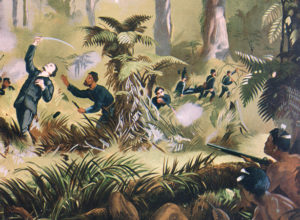 Today in New Zealand history, 7 September, 1868: Te Ngutu O Te Manu/’The beak of the bird’: McAttack!
Today in New Zealand history, 7 September, 1868: Te Ngutu O Te Manu/’The beak of the bird’: McAttack!
Chief Titokowaru picked up the Hauhau mantle after it’s creator, Te Ua, died at the end of 1866. From mid-1868 the cannibalistic cult leader rebelled against New Zealand, murdering and destroying and thieving about South Taranaki.
“Te Ua and other leaders were all ex-Wesleyan converts on the rebound. The theological result was a special fusion of Old Testament Judaism and the in-crisis remnants of the Maori witchdoctor caste.”- 1861: Hauhau; AHNZ
Very successful, the cult was never defeated from without but collapsed from within after less than a year.
McAttack!
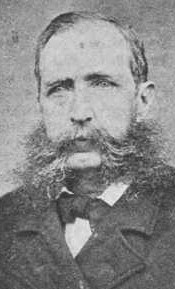 The Armed Constabulary (AC) tried to put an end to the Titokowaru Rebellion, attacking his fortified pa- The Beak of the Bird.
The Armed Constabulary (AC) tried to put an end to the Titokowaru Rebellion, attacking his fortified pa- The Beak of the Bird.
“I have begun to eat the flesh of the white man . . . My throat is continually open for the eating of human flesh by day and night.“- Titokowaru
Lt. Colonel Thomas McDonnell led the AC to this disastrous assault that also claimed the life of famous soldier Gustavus von Tempsky (image top.) Titokowaru’s guys popped out like Gummy Bears while Mc’s lot waste effort on the pa’s decoy structures. Hesitant and unable to get their act together, the Constabulary retreat. Disgusted, von Tempsky’s division disbanded. Titokowaru and his people were delighted in glory.
“I find it memesome how the man obsessed with combat knife fighting and insisted all his men get bowie knives and take knife fighting training, got domed in the forehead by a maori enfield” – Julian Holdsworth, comment to AHNZ (2021)
After-Battle Social Media
The interesting thing that happened after this hard brush with death in the bushes is that the volunteers of the AC now sat for photographs. Back in Whanganui, licking their wounds, the opportunity was taken that has left us lots of history resources to view…
“There are a disproportionate number of images in the Gordon collection of those wounded after Te Ngutu o te Manu than other battles in the wars of the 1860s”- Caitlin Lynch; ‘Frown for the camera’: The unsettling gaze of the New Zealand wars wounded; blog.tepapa.govt.nz
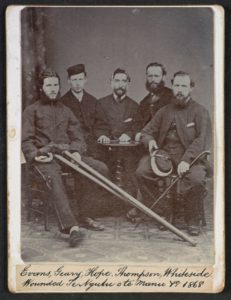 It’s not entirely clear what Lynch means by that. Disproportionate to this one battle or disproportionate as a share of the total collection?
It’s not entirely clear what Lynch means by that. Disproportionate to this one battle or disproportionate as a share of the total collection?
Te Nguto O Te Manu (1868) is really the last time many New Zealanders were bloodied putting down rebellions. The more recent the events, the more photographic coverage we can expect to go with it, right? A bit like how there is more television coverage of Commonwealth Games 2018 than Empire Games 1962.
There has seldom been occasion to photograph war-wounded men of the Maori Wars apart from Te Nguto O Te Manu, especially during the 1860s. Most of the whole time the body damage was on the rebel tribes’ side whose meagre resources were very short on cameras, dark rooms, and developing chemicals! So what do you expect, Caitlin?
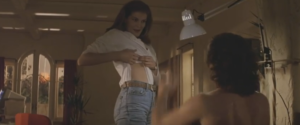 As to why warriors present themselves in photos with the signs of their injuries, I think it was badge of honour.¹ Men do it around rugby, boys do it in the playground. Mel Gibson did it in Lethal Weapon 3. It’s perhaps a little regressive but what school boy hasn’t enjoyed some temporary attention from a new scar or burn or even his arm in a sling?
As to why warriors present themselves in photos with the signs of their injuries, I think it was badge of honour.¹ Men do it around rugby, boys do it in the playground. Mel Gibson did it in Lethal Weapon 3. It’s perhaps a little regressive but what school boy hasn’t enjoyed some temporary attention from a new scar or burn or even his arm in a sling?
—
1 As in Honour Culture
Image ref. Kennett Watkins painting; Alexander Turnbull Library; NZHistory.gov
Image ref. Lt. Colonel Thomas McDonnell; Wikipedia
Image ref. Evans, Geary, Hope, Thompson, Whiteside, wounded Te Ngutu o te Manu 1868; William Francis Gordon; Gordon collection; Museum of New Zealand
 Like Comment Share
Like Comment Share

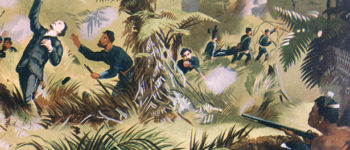




One thought on "1868: The Beak of the Bird"